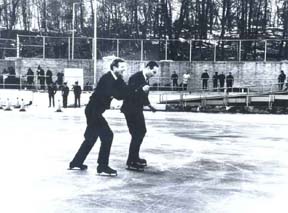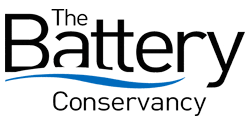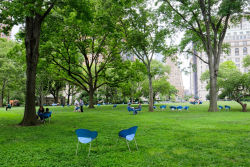The Battery
The Daily Plant : Tuesday, December 26, 2000
THE PLANT REMEMBERS MAYOR LINDSAY

New York City Parks Photo Archive
You've seen Thirteen Years Ago Today In The Plant, now how about Thirty-four Years Ago at Parks? Thirty-four years and 5 days ago, Lasker Rink opened to the public, and Mayor Lindsay and Parks Commissioner Thomas P. F. Hoving took an inaugural sweep across the ice. One, apparently, more tentatively than the other. On the occasion of Mayor Lindsay's death, The Plant recalls Parks in the first years of his administration.
One month before the election, Lindsay recruited then curator of the Cloisters, the Medieval Branch of the Metropolitan Museum of Art, Thomas P. F. Hoving to draft "The White Papers" a proposal for Parks policy, alternately referred to as The White Papers and The Green Papers, that informed Lindsay's choices and secured Hoving's appointment as Parks Commissioner.
Hoving believed "Parks should be the scene of the celebration of communal life." He served only one year, but in that time initiated contemporary art and musical events that drew new users-and large numbers of them-to the parks. He also appointed a precocious 29-year old, Henry J. Stern, Executive Director of Parks. Hoving's administration led the way for the adventure playground movement and a sweet incentive to bikers and pedestrians: a Central Park closed to traffic on weekends and holidays. His successor, August Heckscher, also pioneered new uses for the Parks. In public expression of his ideas Heckscher took down "No" signs in parks and replaced them with "Yes, enjoy" signs that encouraged a range of park activities. The Hoving and Heckscher administration were characterized by a search to define appropriate park uses and determine what sort of events warranted permits. In one case, it came down to a tussle between Mayor Lindsay and Commissioner Heckscher when the mayor overrode Heckscher's prior commitment to a Girl Scout's Jubilee on the Sheep's Meadow and permitted a poor people's protest instead. Battles like these and huge events like an anti-war protest on the Sheep's Meadow-the largest to date in 1967-helped crystallize the issue of appropriate use, and pose questions about the relative priorities of active use and natural conservation.
Thanks to Director of Art and Antiquities Jonathan (Archive) Kuhn for the photographs and source material.
THIRTEEN YEARS AGO IN THE PLANT
(Tuesday, December 29, 1987)
PARKS PLANNING: REPORT ON 1987
As a rule, the Planning Division makes a point of keeping both eyes on the future. But, as the end of the year approaches, the Plant encouraged Planning to glance back at the division's many accomplishments during 1987, including the completion of several significant management plans, applications for state, federal and private funding, and the development of policies concerning parkland acquisition, open space, and improvement of the city's vast waterfront.
Currently, Planning has a total of nearly 100 projects underway, including development of Bryant and Battery Parks in Manhattan, a Brooklyn-Queens Greenway proposal and creation of bayside Marina, a ferry service between Manhattan and Queens.
QUOTATION FOR THE DAY
"The struggle of man against power
is the struggle of memory against forgetting"
Milan Kundera (b. 1929)
Check out your park's Vital Signs
Clean & Safe
Green & Resilient
Empowered & Engaged Users
Share your feedback or learn more about how this park is part of a
Vital Park System

Know Before You Go











